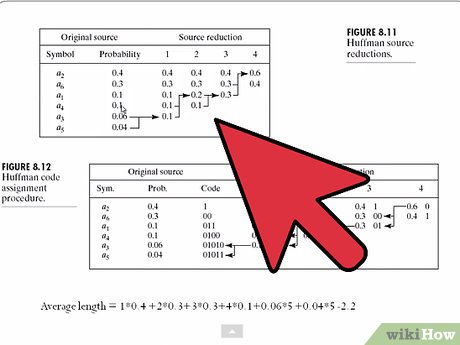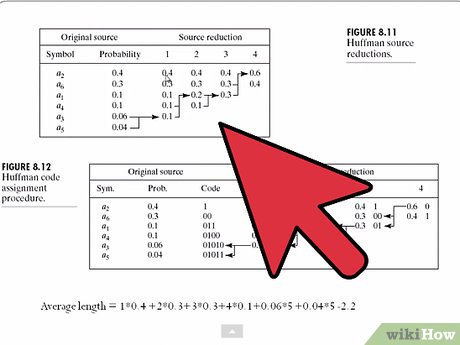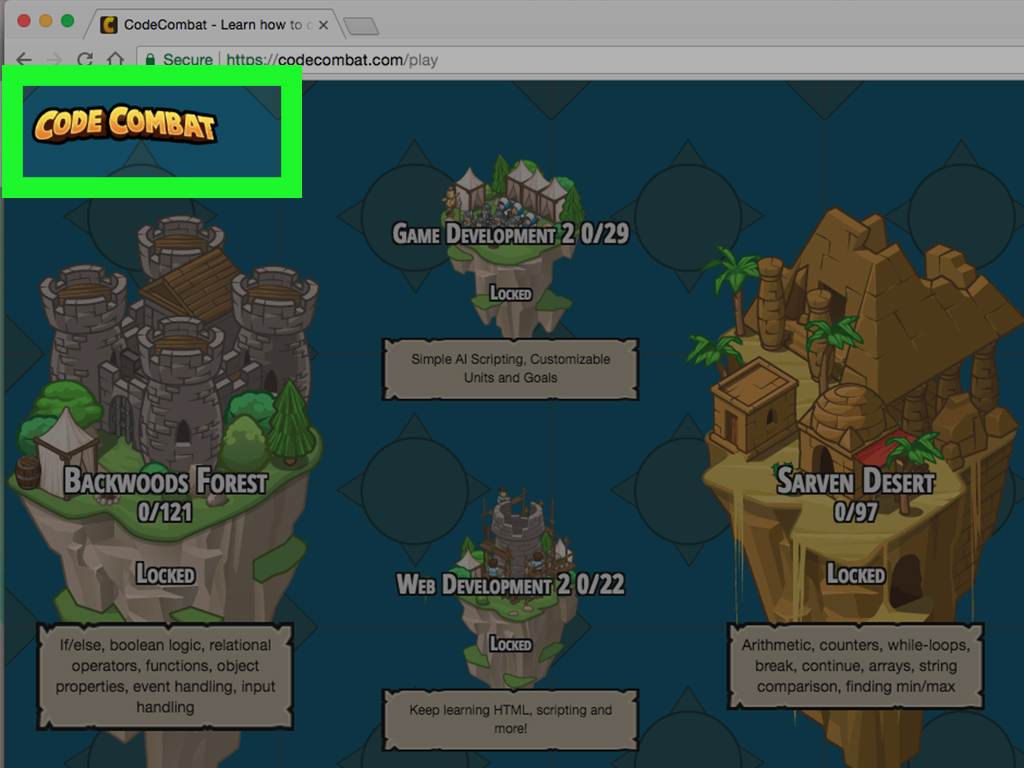How to Compress Data Using Huffman Encoding
Part 1 of 2:
Encoding
-
 Count the frequency of each character in the file to be encoded. Include a dummy character to mark the end of the file -- this will be important later. For now, call it the EOF (end of file) and mark it as having a frequency of 1.
Count the frequency of each character in the file to be encoded. Include a dummy character to mark the end of the file -- this will be important later. For now, call it the EOF (end of file) and mark it as having a frequency of 1.- For example, if you want to encode a text file reading "ab ab cab," you would have 'a' with frequency 3, 'b' with frequency 3, ' ' (space) with frequency 2, 'c' with frequency 1, and EOF with frequency 1.
-
 Store characters as tree nodes and put them into a priority queue. You'll be building a big binary tree with each character as a leaf, so you should store the characters in a format such that they can become nodes of the tree. Place these nodes into a priority queue with each character's frequency as its node's priority.
Store characters as tree nodes and put them into a priority queue. You'll be building a big binary tree with each character as a leaf, so you should store the characters in a format such that they can become nodes of the tree. Place these nodes into a priority queue with each character's frequency as its node's priority.- A binary tree is a data format where each piece of data is a node that can have up to one parent and two children. It's often drawn as a branching tree, hence the name.
- A queue is an aptly named data collection where the first thing to go into the queue is also the first thing to come out (like waiting in line). In a priority queue, the data are stored in order of their priority, so that the first thing to come out is the most urgent thing, the thing with the smallest priority, rather than the first thing enqueued.
- In the "ab ab cab" example, your priority queue would look like this: {'c':1, EOF:1, ' ':2, 'a':3, 'b':3}
-
 Begin to build your tree. Remove (or dequeue) the two most urgent things from the priority queue. Create a new tree node to be the parent of these two nodes, storing the first node as its left child and the second as its right child. The priority of the new node should be the sum of the priorities of its child. Then enqueue this new node in the priority queue.
Begin to build your tree. Remove (or dequeue) the two most urgent things from the priority queue. Create a new tree node to be the parent of these two nodes, storing the first node as its left child and the second as its right child. The priority of the new node should be the sum of the priorities of its child. Then enqueue this new node in the priority queue.- The priority queue now looks like this: {' ':2, new node:2, 'a':3, 'b':3}
-
 Finish building your tree: repeat the above step until there is only one node in the queue. Note that in addition to the nodes you created for the characters and their frequencies, you will also be dequeuing, turning into trees, and re-enqueueing parent nodes, nodes that are already themselves trees.
Finish building your tree: repeat the above step until there is only one node in the queue. Note that in addition to the nodes you created for the characters and their frequencies, you will also be dequeuing, turning into trees, and re-enqueueing parent nodes, nodes that are already themselves trees.- When you're finished, the last node in the queue will be the root of the encoding tree, with all the other nodes branching off from it.
- The most frequently used characters will be the leaves closest to the top of the tree, while the rarely used characters will be positioned at the bottom of the tree, farther away from the root.
-
 Create an encoding map. Walk through the tree to reach each character. Every time you visit a node's left child, that's a '0'. Every time you visit a node's right child, that's a '1'. When you get to a character, store the character with the sequence of 0s and 1s that it took to get there. This sequence is what the character will be encoded as in the compressed file. Store the characters and their sequences in a map.
Create an encoding map. Walk through the tree to reach each character. Every time you visit a node's left child, that's a '0'. Every time you visit a node's right child, that's a '1'. When you get to a character, store the character with the sequence of 0s and 1s that it took to get there. This sequence is what the character will be encoded as in the compressed file. Store the characters and their sequences in a map.- For example, start at the root. Visit the root's left child, and then visit that node's left child. Since the node you're at now doesn't have any children, you've reached a character. This is ' '. Since you walked left twice to get here, the encoding for ' ' is "00".
- For this tree, the map will look like this: {' ':"00", 'a':"10", 'b':"11", 'c':"010", EOF:"011"}.
-
 In the output file, include the encoding map as a header. This will allow the file to be decoded.
In the output file, include the encoding map as a header. This will allow the file to be decoded. -
 Encode the file. For each character in the file to be encoded, write the binary sequence you've stored in the map. Once you've finished encoding the file, make sure to add the EOF to the end.
Encode the file. For each character in the file to be encoded, write the binary sequence you've stored in the map. Once you've finished encoding the file, make sure to add the EOF to the end.- For the file "ab ab cab", the encoded file will look like this: "1011001011000101011011".
- Files are stored as bytes (8 bits, or 8 binary digits). Because the Huffman Encoding algorithm doesn't use the 8-bit format, encoded files will often not have lengths that are multiples of 8. The remaining digits will be filled in with 0s. In this case, two 0s would be added at the end of the file, which looks like another space. This could be a problem: how would the decoder know when to stop reading? However, because we included an end-of-file character, the decoder will get to this and then stop, ignoring anything else that's been added on after.
Part 2 of 2:
Decoding
-
 Read in a Huffman-encoded file. First, read the header, which should be the encoding map. Use this to build a decoding tree in the same way you built the tree you used to encode the file. The two trees should be identical.
Read in a Huffman-encoded file. First, read the header, which should be the encoding map. Use this to build a decoding tree in the same way you built the tree you used to encode the file. The two trees should be identical. -
 Read in the binary one digit at a time. Traverse the tree as you read: if you read in a '0', go to the left child of the node you're at, and if you read in a '1', go to the right child. When you reach a leaf (a node without any children), you've arrived at a character. Write the character into the decoded file.
Read in the binary one digit at a time. Traverse the tree as you read: if you read in a '0', go to the left child of the node you're at, and if you read in a '1', go to the right child. When you reach a leaf (a node without any children), you've arrived at a character. Write the character into the decoded file.- Because of the way the characters are stored in the tree, the codes for each character have a prefix property, so that no character's binary encoding can ever occur at the start of another character's encoding. The encoding for each character is totally unique. This makes decoding much easier.
-
 Repeat until you reach the EOF. Congratulations! You've decoded the file.
Repeat until you reach the EOF. Congratulations! You've decoded the file.
3.6 ★ | 8 Vote
You should read it
May be interested
- How to Make a Scrolling Marquee in HTML
 a scrolling marquee is moving text added to a website, but html is no longer commonly used for this feature and is not recommended. the html tag for scrolling marquees has been deleted from the standard html library. to accomplish a...
a scrolling marquee is moving text added to a website, but html is no longer commonly used for this feature and is not recommended. the html tag for scrolling marquees has been deleted from the standard html library. to accomplish a... - How to Practice Hadoop Online
 as one of the most powerful open-source programming frameworks, hadoop is an important tool for anyone hoping to find a big data job. if you want to brush up on your hadoop skills or learn how to master it, your best option is to take an...
as one of the most powerful open-source programming frameworks, hadoop is an important tool for anyone hoping to find a big data job. if you want to brush up on your hadoop skills or learn how to master it, your best option is to take an... - How to Develop an Interest in Coding
 in our high-tech society, knowing how to code can land you a great job or come in handy as a hobby. but writing lines of code can sound intimidating or even boring. thinking of coding as an outlet for creativity, a way to dig deeper into...
in our high-tech society, knowing how to code can land you a great job or come in handy as a hobby. but writing lines of code can sound intimidating or even boring. thinking of coding as an outlet for creativity, a way to dig deeper into... - How to Program
 ever wanted to program but just didn't know how to go about it? programming can range from easy to very difficult, depending on what you want to do or what languages you want to use. read on to help you find resources. understand comments....
ever wanted to program but just didn't know how to go about it? programming can range from easy to very difficult, depending on what you want to do or what languages you want to use. read on to help you find resources. understand comments.... - How to Write a C++ Program That Determines if a Word Is a Palindrome or Not
 these instructions will guide you in writing a computer program in c++ that will tell the user if a particular word is a palindrome (a word that reads the same backward as it does forward, such as 'madam'). the instructions assume the user...
these instructions will guide you in writing a computer program in c++ that will tell the user if a particular word is a palindrome (a word that reads the same backward as it does forward, such as 'madam'). the instructions assume the user... - How to Learn Computer Programming Online at Home
 computer programming is an invaluable skill for anyone who would like to build and design computer programs, software, or phone or tablet apps. fortunately, you don't have to enroll in an in-seat college to learn how to think like a...
computer programming is an invaluable skill for anyone who would like to build and design computer programs, software, or phone or tablet apps. fortunately, you don't have to enroll in an in-seat college to learn how to think like a...












 Zip bomb can compress 4.5 million GB of data into a 46MB file
Zip bomb can compress 4.5 million GB of data into a 46MB file How to compress and decompress files on Windows 11
How to compress and decompress files on Windows 11 How to compress videos with Handbrake
How to compress videos with Handbrake How to compress files on YouCompress online
How to compress files on YouCompress online How to compress and decompress files with WinRAR on the computer
How to compress and decompress files with WinRAR on the computer